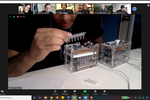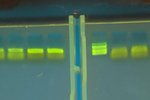Meet the Genes in Space Toolkit: the P51 fluorescence viewer
Genes in Space asks students to design original DNA experiments that address real-life challenges and opportunities in space exploration using the Genes in Space Toolkit, a suite of biotechnology tools available aboard the ISS. In previous years, all proposals had to make use of the polymerase chain reaction (PCR). However, in 2021 two new tools, the BioBits® cell-free system and P51™ molecular fluorescence viewer, have been added to the toolkit.
To help applicants become more familiar with the Genes in Space Toolkit, we have featured each tool series of webinars and blog posts. Today's post focuses on the P51TM fluorescence viewer, a convenient, low-cost system for viewing fluorescent molecules. Fluorescence can be used as a tool to visualize things that would otherwise be invisible. Some biomolecules, like fluorescent proteins, are naturally fluorescent while other biomolecules, like DNA or RNA, can be made to fluoresce using special chemicals. By combining fluorescence and the P51TM we can develop easy readouts for experimental results without needing complicated machinery.
Below we summarize some of the P51TM resources that can help you to learn more about this versatile technique. Be sure to check out our P51TM webinar by miniPCR bio's Dr. Emily Gleason below.
Webinar: Meet the Genes in Space Toolkit: P51TM fluorescence viewer:
Helpful P51TM resources:
Watch miniPCR bio's fluorescence webinars HERE and HERE
Purchase the P51TM for use in your classroom or @home
Common uses of fluorescence in biology:
qPCR: Read about qPCR and watch our qPCR webinar
Biosensors using cell-free technology: webinar
Visualizing fluorescent proteins with BioBits®: watch a short video or a webinar


